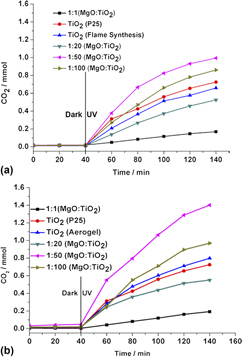Crossref Citations
This article has been cited by the following publications. This list is generated based on data provided by
Crossref.
Liu, Lianjun
Zhao, Cunyu
Pitts, Daniel
Zhao, Huilei
and
Li, Ying
2014.
CO2photoreduction with H2O vapor by porous MgO–TiO2microspheres: effects of surface MgO dispersion and CO2adsorption–desorption dynamics.
Catal. Sci. Technol.,
Vol. 4,
Issue. 6,
p.
1539.
Wu, Jia Wen
Yao, Lan Fang
Shen, Jun
Zu, Guo Qing
and
Wang, Fang
2014.
Preparation and Characterization of Magnesium Oxide Aerogels.
Advanced Materials Research,
Vol. 936,
Issue. ,
p.
374.
Nouri, H.
and
Habibi-Yangjeh, A.
2014.
Microwave-assisted method for preparation of Zn1−xMgxO nanostructures and their activities for photodegradation of methylene blue.
Advanced Powder Technology,
Vol. 25,
Issue. 3,
p.
1016.
Dahl, Michael
Liu, Yiding
and
Yin, Yadong
2014.
Composite Titanium Dioxide Nanomaterials.
Chemical Reviews,
Vol. 114,
Issue. 19,
p.
9853.
Bayal, Nisha
and
Jeevanandam, P.
2014.
Synthesis of TiO2−MgO mixed metal oxide nanoparticles via a sol−gel method and studies on their optical properties.
Ceramics International,
Vol. 40,
Issue. 10,
p.
15463.
Lu, Zeyu
Chen, Guochang
Hao, Wenbin
Sun, Guoxing
and
Li, Zongjin
2015.
Mechanism of UV-assisted TiO2/reduced graphene oxide composites with variable photodegradation of methyl orange.
RSC Advances,
Vol. 5,
Issue. 89,
p.
72916.
Chen, Lifeng
Bai, Peng
Fan, Hongtao
Yu, Wei
Guo, Hongfan
and
Li, Wenxiu
2015.
Morphology and structure of nano MgO prepared by a novel nitrogen-protective pressurization method.
RSC Adv.,
Vol. 5,
Issue. 56,
p.
44778.
Karimi, Mohammad Ali
Hatefi-Mehrjardi, Abdolhamid
Askarpour Kabir, Asghar
and
Zaydabadi, Mahdieh
2015.
Synthesis, characterization, and application of MgO/ZnO nanocomposite supported on activated carbon for photocatalytic degradation of methylene blue.
Research on Chemical Intermediates,
Vol. 41,
Issue. 9,
p.
6157.
Chen, Lifeng
Fan, Hongtao
Li, Wenxiu
and
Bai, Peng
2015.
A Novel Nitrogen Protective Pressurization Method to Fabricate Nano Magnesium Oxide.
Chemistry Letters,
Vol. 44,
Issue. 10,
p.
1318.
Sharma, Urvashi
and
Jeevanandam, P.
2016.
Synthesis of Titanium-doped MgO heteronanostructures with tunable band gap.
Journal of Nanoparticle Research,
Vol. 18,
Issue. 4,
Kumar, Pardeep
Kundu, Virender Singh
Kumar, Suresh
Saharan, Baljeet
Kumar, Vanish
and
Chauhan, Nikhil
2017.
Hydrothermal Synthesis of Cu-ZnO-/TiO2-Based Engineered Nanomaterials for the Efficient Removal of Organic Pollutants and Bacteria from Water.
BioNanoScience,
Vol. 7,
Issue. 4,
p.
574.
Selvaratnam, Balaranjan
and
Koodali, Ranjit T.
2018.
TiO2-MgO mixed oxide nanomaterials for solar energy conversion.
Catalysis Today,
Vol. 300,
Issue. ,
p.
39.
Akilandeswari, S.
Rajesh, G.
Govindarajan, D.
Thirumalai, K.
and
Swaminathan, M.
2018.
Efficacy of photoluminescence and photocatalytic properties of Mn doped ZrO2 nanoparticles by facile precipitation method.
Journal of Materials Science: Materials in Electronics,
Vol. 29,
Issue. 21,
p.
18258.
Meng, Fanchao
Dehouche, Zahir
Nutasarin, Aorrapum
and
Fern, George R.
2018.
Effective MgO-doped TiO2
nanoaerogel coating for crystalline silicon solar cells improvement.
International Journal of Energy Research,
Vol. 42,
Issue. 12,
p.
3915.
Sugumaran, Sathish
Bellan, Chandar Shekar
and
Devaraj, Nataraj
2018.
Novel mixed cubic-rutile structured In2O3-TiO2 composite nanoparticles (InTiO CNPs): Structure, morphology, photoluminescence and photocatalytic activity.
Optik,
Vol. 174,
Issue. ,
p.
15.
Tahir, Muhammad Bilal
Rafique, Muhammad
Rafique, Muhammad Shahid
Fatima, Nisar
and
Israr, Zeba
2020.
Nanotechnology and Photocatalysis for Environmental Applications.
p.
77.
Bekena, FekaduTadesse
and
Kuo, Dong-Hau
2020.
10 nm sized visible light TiO2 photocatalyst in the presence of MgO for degradation of methylene blue.
Materials Science in Semiconductor Processing,
Vol. 116,
Issue. ,
p.
105152.
Mahendran, N.
Jeyakumar, S. Johnson
and
Ponnar, M.
2021.
Structural, optical and electrical properties of copper composite ZrO2 nanoparticles prepared via sol–gel method.
Journal of Materials Science: Materials in Electronics,
Vol. 32,
Issue. 18,
p.
23399.
Doudin, Nassar
Collinge, Greg
Persaud, Rudradatt R.
Gurunathan, Pradeep Kumar
Lee, Mal-Soon
Glezakou, Vassiliki-Alexandra
Dixon, David A.
Rousseau, Roger
and
Dohnálek, Zdenek
2021.
Binding and stability of MgO monomers on anatase TiO2(101).
The Journal of Chemical Physics,
Vol. 154,
Issue. 20,
Avramescu, Sorin
Ene, Cristian D.
Ciobanu, Madalina
Schnee, Josefine
Devred, Francois
Bucur, Cristina
Vasile, Eugeniu
Colaciello, Luke
Richards, Ryan
Gaigneaux, Eric M.
and
Verziu, Marian Nicolae
2022.
Nanocrystalline rhenium-doped TiO2: an efficient catalyst in the one-pot conversion of carbohydrates into levulinic acid. The synergistic effect between Brønsted and Lewis acid sites.
Catalysis Science & Technology,
Vol. 12,
Issue. 1,
p.
167.





